PUBH7117: Hepatitis B Prevention Strategies in Pakistan - A Review
VerifiedAdded on 2023/06/11
|22
|5575
|227
Literature Review
AI Summary
This systematic review examines strategies and interventions for Hepatitis B prevention in Pakistan. The review analyzes peer-reviewed literature from 1968 onwards, focusing on incidence, prevalence, lifestyle factors, and policies. Initial searches yielded 481 papers, with 11 meeting the inclusion criteria, highlighting the scarcity of research specifically addressing the Pakistani context. The review identifies key areas for intervention, including public awareness campaigns to educate the population on transmission, symptoms, and prevention methods. It emphasizes the need for culturally tailored interventions considering the socioeconomic, political, and developmental landscape of Pakistan, given that existing studies predominantly focus on developed nations. The research highlights the importance of preparedness and primary care interventions to effectively curb the spread of Hepatitis B in Pakistan.
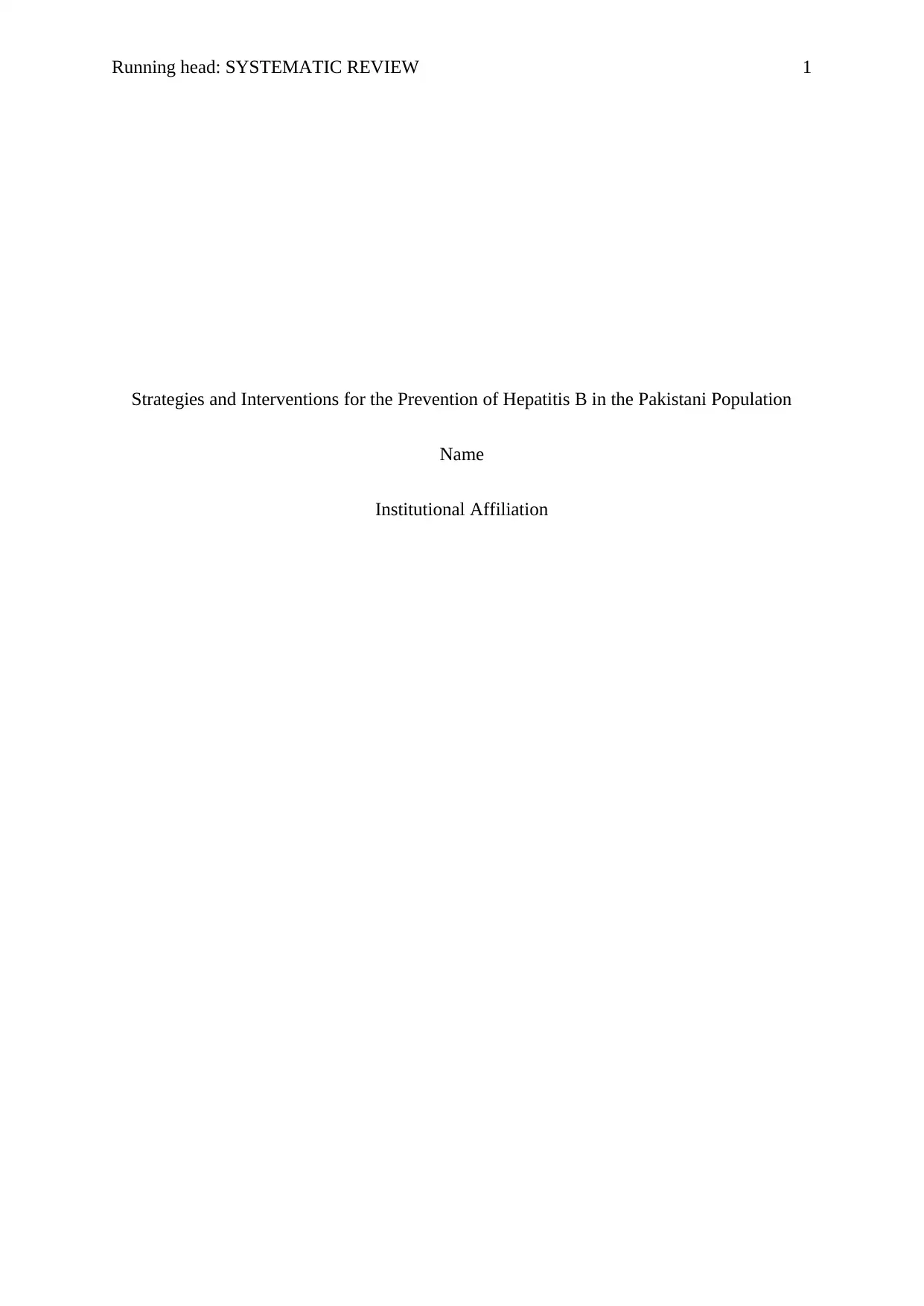
Running head: SYSTEMATIC REVIEW 1
Strategies and Interventions for the Prevention of Hepatitis B in the Pakistani Population
Name
Institutional Affiliation
Strategies and Interventions for the Prevention of Hepatitis B in the Pakistani Population
Name
Institutional Affiliation
Paraphrase This Document
Need a fresh take? Get an instant paraphrase of this document with our AI Paraphraser
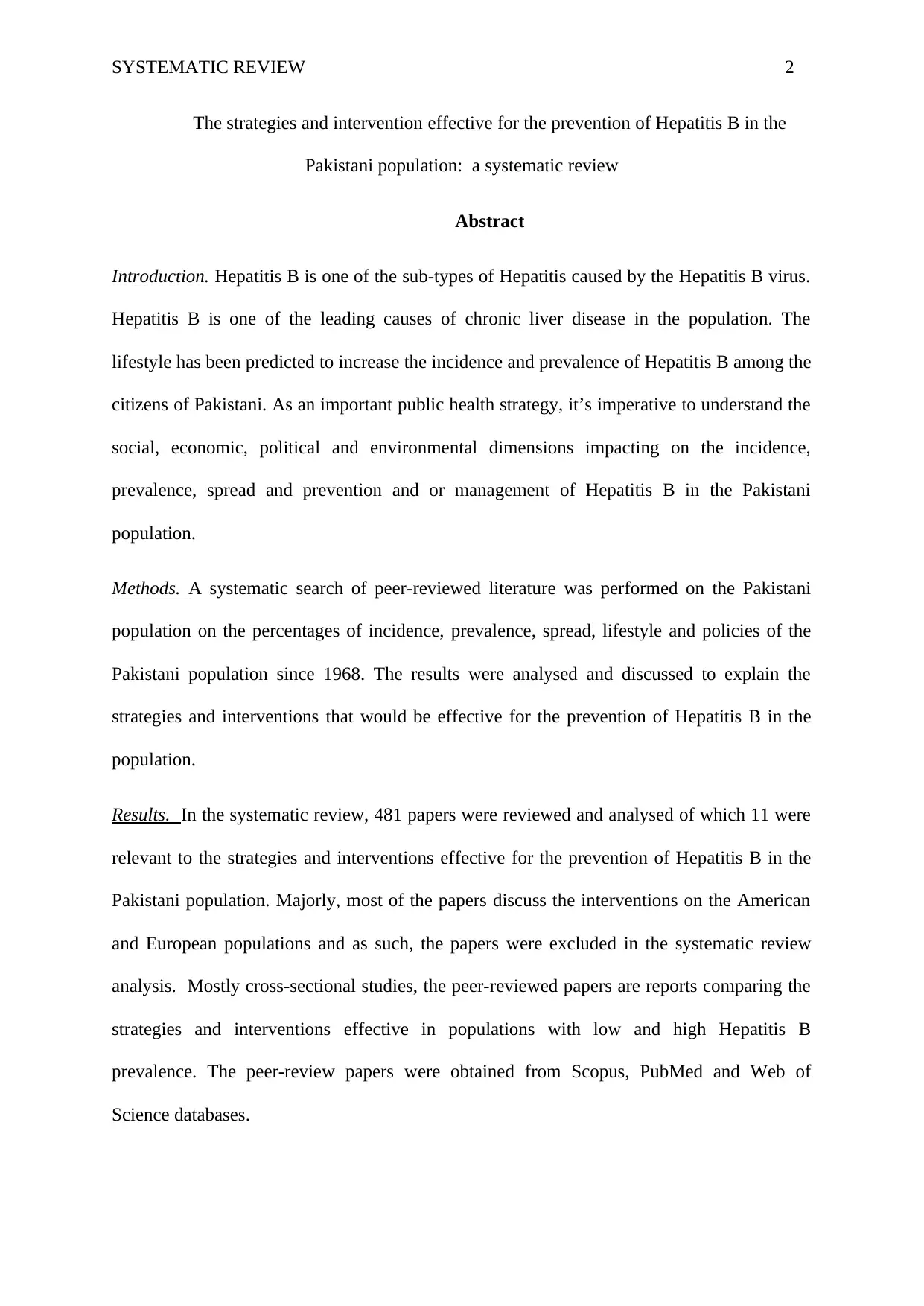
SYSTEMATIC REVIEW 2
The strategies and intervention effective for the prevention of Hepatitis B in the
Pakistani population: a systematic review
Abstract
Introduction. Hepatitis B is one of the sub-types of Hepatitis caused by the Hepatitis B virus.
Hepatitis B is one of the leading causes of chronic liver disease in the population. The
lifestyle has been predicted to increase the incidence and prevalence of Hepatitis B among the
citizens of Pakistani. As an important public health strategy, it’s imperative to understand the
social, economic, political and environmental dimensions impacting on the incidence,
prevalence, spread and prevention and or management of Hepatitis B in the Pakistani
population.
Methods. A systematic search of peer-reviewed literature was performed on the Pakistani
population on the percentages of incidence, prevalence, spread, lifestyle and policies of the
Pakistani population since 1968. The results were analysed and discussed to explain the
strategies and interventions that would be effective for the prevention of Hepatitis B in the
population.
Results. In the systematic review, 481 papers were reviewed and analysed of which 11 were
relevant to the strategies and interventions effective for the prevention of Hepatitis B in the
Pakistani population. Majorly, most of the papers discuss the interventions on the American
and European populations and as such, the papers were excluded in the systematic review
analysis. Mostly cross-sectional studies, the peer-reviewed papers are reports comparing the
strategies and interventions effective in populations with low and high Hepatitis B
prevalence. The peer-review papers were obtained from Scopus, PubMed and Web of
Science databases.
The strategies and intervention effective for the prevention of Hepatitis B in the
Pakistani population: a systematic review
Abstract
Introduction. Hepatitis B is one of the sub-types of Hepatitis caused by the Hepatitis B virus.
Hepatitis B is one of the leading causes of chronic liver disease in the population. The
lifestyle has been predicted to increase the incidence and prevalence of Hepatitis B among the
citizens of Pakistani. As an important public health strategy, it’s imperative to understand the
social, economic, political and environmental dimensions impacting on the incidence,
prevalence, spread and prevention and or management of Hepatitis B in the Pakistani
population.
Methods. A systematic search of peer-reviewed literature was performed on the Pakistani
population on the percentages of incidence, prevalence, spread, lifestyle and policies of the
Pakistani population since 1968. The results were analysed and discussed to explain the
strategies and interventions that would be effective for the prevention of Hepatitis B in the
population.
Results. In the systematic review, 481 papers were reviewed and analysed of which 11 were
relevant to the strategies and interventions effective for the prevention of Hepatitis B in the
Pakistani population. Majorly, most of the papers discuss the interventions on the American
and European populations and as such, the papers were excluded in the systematic review
analysis. Mostly cross-sectional studies, the peer-reviewed papers are reports comparing the
strategies and interventions effective in populations with low and high Hepatitis B
prevalence. The peer-review papers were obtained from Scopus, PubMed and Web of
Science databases.
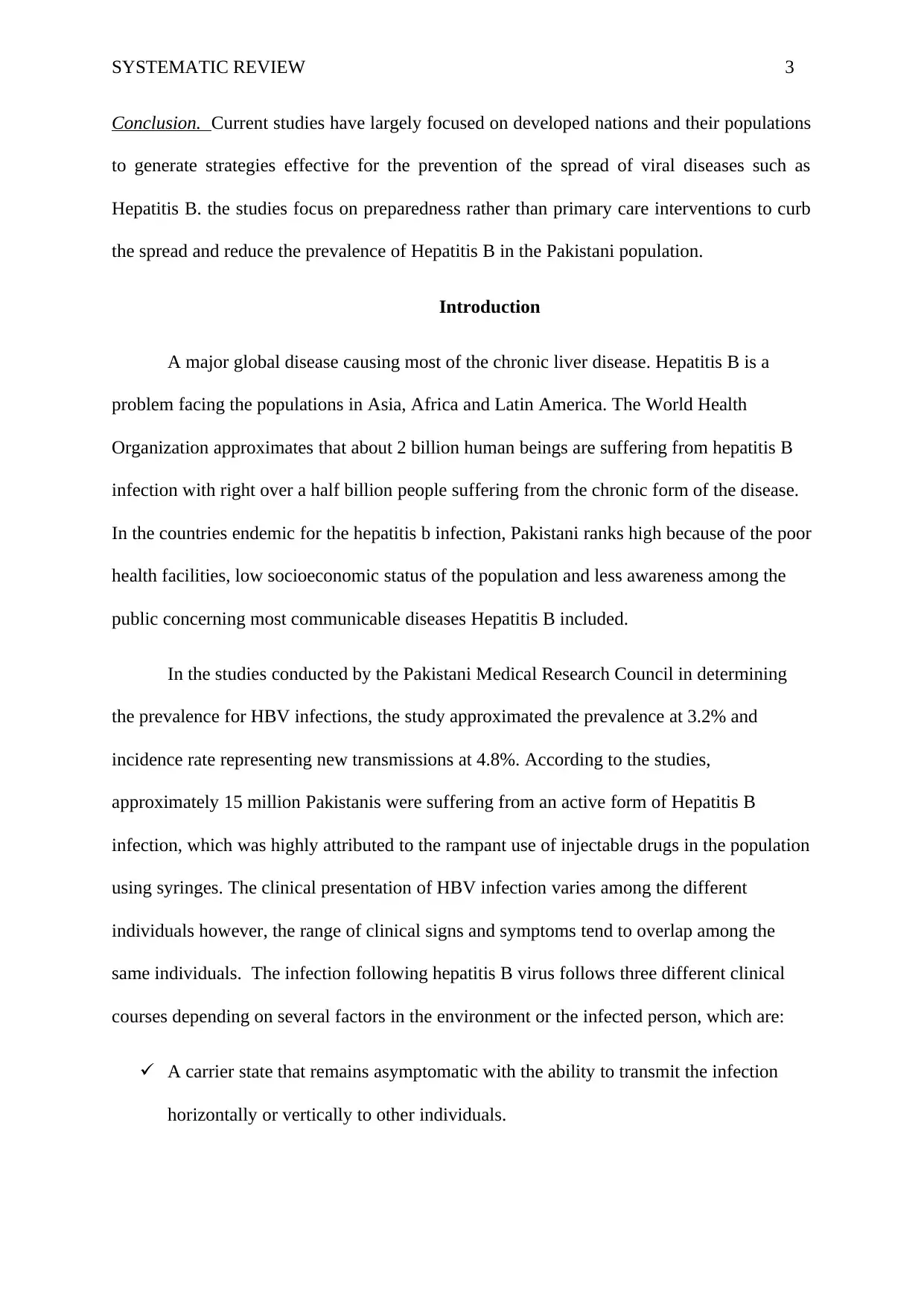
SYSTEMATIC REVIEW 3
Conclusion. Current studies have largely focused on developed nations and their populations
to generate strategies effective for the prevention of the spread of viral diseases such as
Hepatitis B. the studies focus on preparedness rather than primary care interventions to curb
the spread and reduce the prevalence of Hepatitis B in the Pakistani population.
Introduction
A major global disease causing most of the chronic liver disease. Hepatitis B is a
problem facing the populations in Asia, Africa and Latin America. The World Health
Organization approximates that about 2 billion human beings are suffering from hepatitis B
infection with right over a half billion people suffering from the chronic form of the disease.
In the countries endemic for the hepatitis b infection, Pakistani ranks high because of the poor
health facilities, low socioeconomic status of the population and less awareness among the
public concerning most communicable diseases Hepatitis B included.
In the studies conducted by the Pakistani Medical Research Council in determining
the prevalence for HBV infections, the study approximated the prevalence at 3.2% and
incidence rate representing new transmissions at 4.8%. According to the studies,
approximately 15 million Pakistanis were suffering from an active form of Hepatitis B
infection, which was highly attributed to the rampant use of injectable drugs in the population
using syringes. The clinical presentation of HBV infection varies among the different
individuals however, the range of clinical signs and symptoms tend to overlap among the
same individuals. The infection following hepatitis B virus follows three different clinical
courses depending on several factors in the environment or the infected person, which are:
A carrier state that remains asymptomatic with the ability to transmit the infection
horizontally or vertically to other individuals.
Conclusion. Current studies have largely focused on developed nations and their populations
to generate strategies effective for the prevention of the spread of viral diseases such as
Hepatitis B. the studies focus on preparedness rather than primary care interventions to curb
the spread and reduce the prevalence of Hepatitis B in the Pakistani population.
Introduction
A major global disease causing most of the chronic liver disease. Hepatitis B is a
problem facing the populations in Asia, Africa and Latin America. The World Health
Organization approximates that about 2 billion human beings are suffering from hepatitis B
infection with right over a half billion people suffering from the chronic form of the disease.
In the countries endemic for the hepatitis b infection, Pakistani ranks high because of the poor
health facilities, low socioeconomic status of the population and less awareness among the
public concerning most communicable diseases Hepatitis B included.
In the studies conducted by the Pakistani Medical Research Council in determining
the prevalence for HBV infections, the study approximated the prevalence at 3.2% and
incidence rate representing new transmissions at 4.8%. According to the studies,
approximately 15 million Pakistanis were suffering from an active form of Hepatitis B
infection, which was highly attributed to the rampant use of injectable drugs in the population
using syringes. The clinical presentation of HBV infection varies among the different
individuals however, the range of clinical signs and symptoms tend to overlap among the
same individuals. The infection following hepatitis B virus follows three different clinical
courses depending on several factors in the environment or the infected person, which are:
A carrier state that remains asymptomatic with the ability to transmit the infection
horizontally or vertically to other individuals.
⊘ This is a preview!⊘
Do you want full access?
Subscribe today to unlock all pages.

Trusted by 1+ million students worldwide
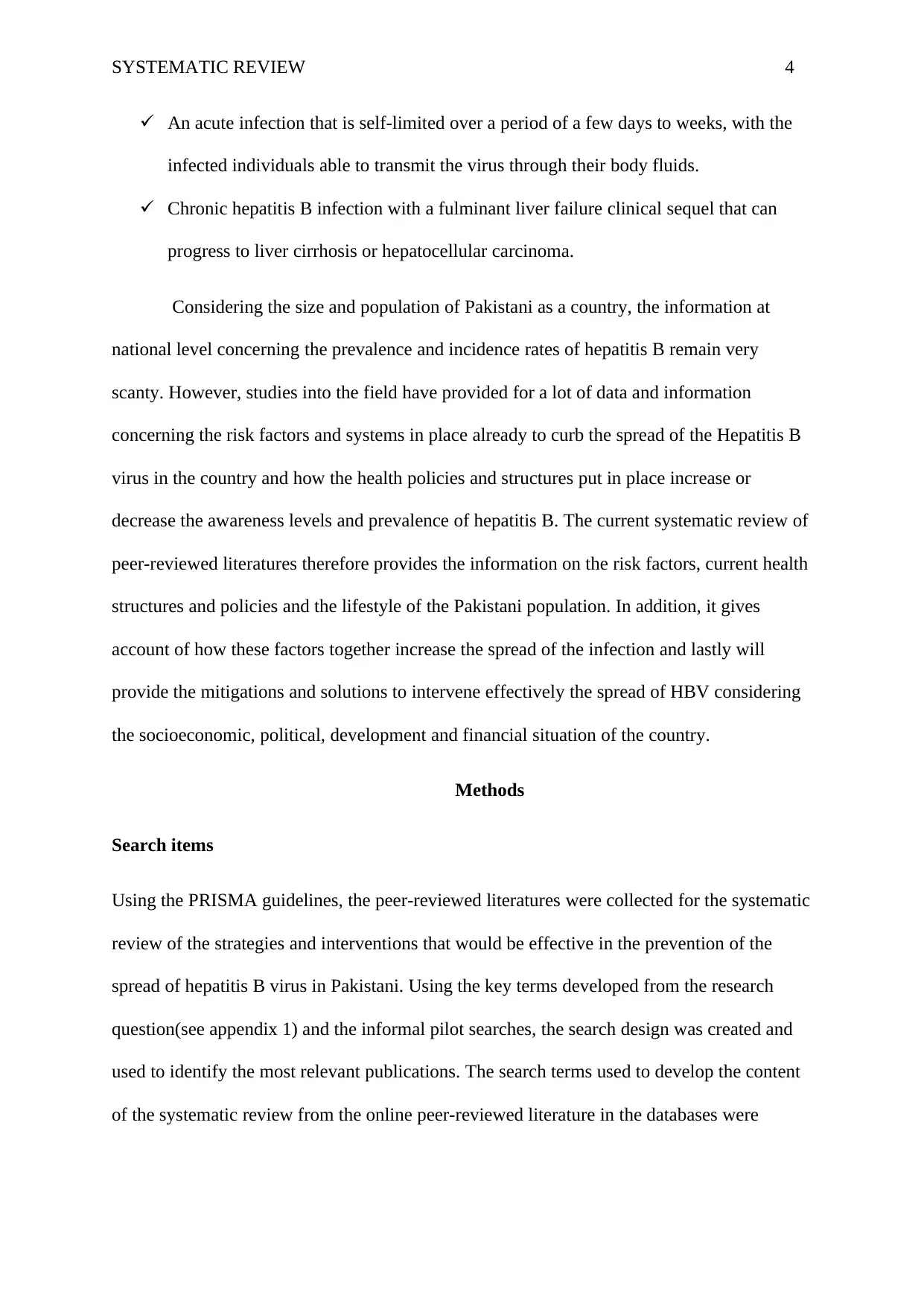
SYSTEMATIC REVIEW 4
An acute infection that is self-limited over a period of a few days to weeks, with the
infected individuals able to transmit the virus through their body fluids.
Chronic hepatitis B infection with a fulminant liver failure clinical sequel that can
progress to liver cirrhosis or hepatocellular carcinoma.
Considering the size and population of Pakistani as a country, the information at
national level concerning the prevalence and incidence rates of hepatitis B remain very
scanty. However, studies into the field have provided for a lot of data and information
concerning the risk factors and systems in place already to curb the spread of the Hepatitis B
virus in the country and how the health policies and structures put in place increase or
decrease the awareness levels and prevalence of hepatitis B. The current systematic review of
peer-reviewed literatures therefore provides the information on the risk factors, current health
structures and policies and the lifestyle of the Pakistani population. In addition, it gives
account of how these factors together increase the spread of the infection and lastly will
provide the mitigations and solutions to intervene effectively the spread of HBV considering
the socioeconomic, political, development and financial situation of the country.
Methods
Search items
Using the PRISMA guidelines, the peer-reviewed literatures were collected for the systematic
review of the strategies and interventions that would be effective in the prevention of the
spread of hepatitis B virus in Pakistani. Using the key terms developed from the research
question(see appendix 1) and the informal pilot searches, the search design was created and
used to identify the most relevant publications. The search terms used to develop the content
of the systematic review from the online peer-reviewed literature in the databases were
An acute infection that is self-limited over a period of a few days to weeks, with the
infected individuals able to transmit the virus through their body fluids.
Chronic hepatitis B infection with a fulminant liver failure clinical sequel that can
progress to liver cirrhosis or hepatocellular carcinoma.
Considering the size and population of Pakistani as a country, the information at
national level concerning the prevalence and incidence rates of hepatitis B remain very
scanty. However, studies into the field have provided for a lot of data and information
concerning the risk factors and systems in place already to curb the spread of the Hepatitis B
virus in the country and how the health policies and structures put in place increase or
decrease the awareness levels and prevalence of hepatitis B. The current systematic review of
peer-reviewed literatures therefore provides the information on the risk factors, current health
structures and policies and the lifestyle of the Pakistani population. In addition, it gives
account of how these factors together increase the spread of the infection and lastly will
provide the mitigations and solutions to intervene effectively the spread of HBV considering
the socioeconomic, political, development and financial situation of the country.
Methods
Search items
Using the PRISMA guidelines, the peer-reviewed literatures were collected for the systematic
review of the strategies and interventions that would be effective in the prevention of the
spread of hepatitis B virus in Pakistani. Using the key terms developed from the research
question(see appendix 1) and the informal pilot searches, the search design was created and
used to identify the most relevant publications. The search terms used to develop the content
of the systematic review from the online peer-reviewed literature in the databases were
Paraphrase This Document
Need a fresh take? Get an instant paraphrase of this document with our AI Paraphraser
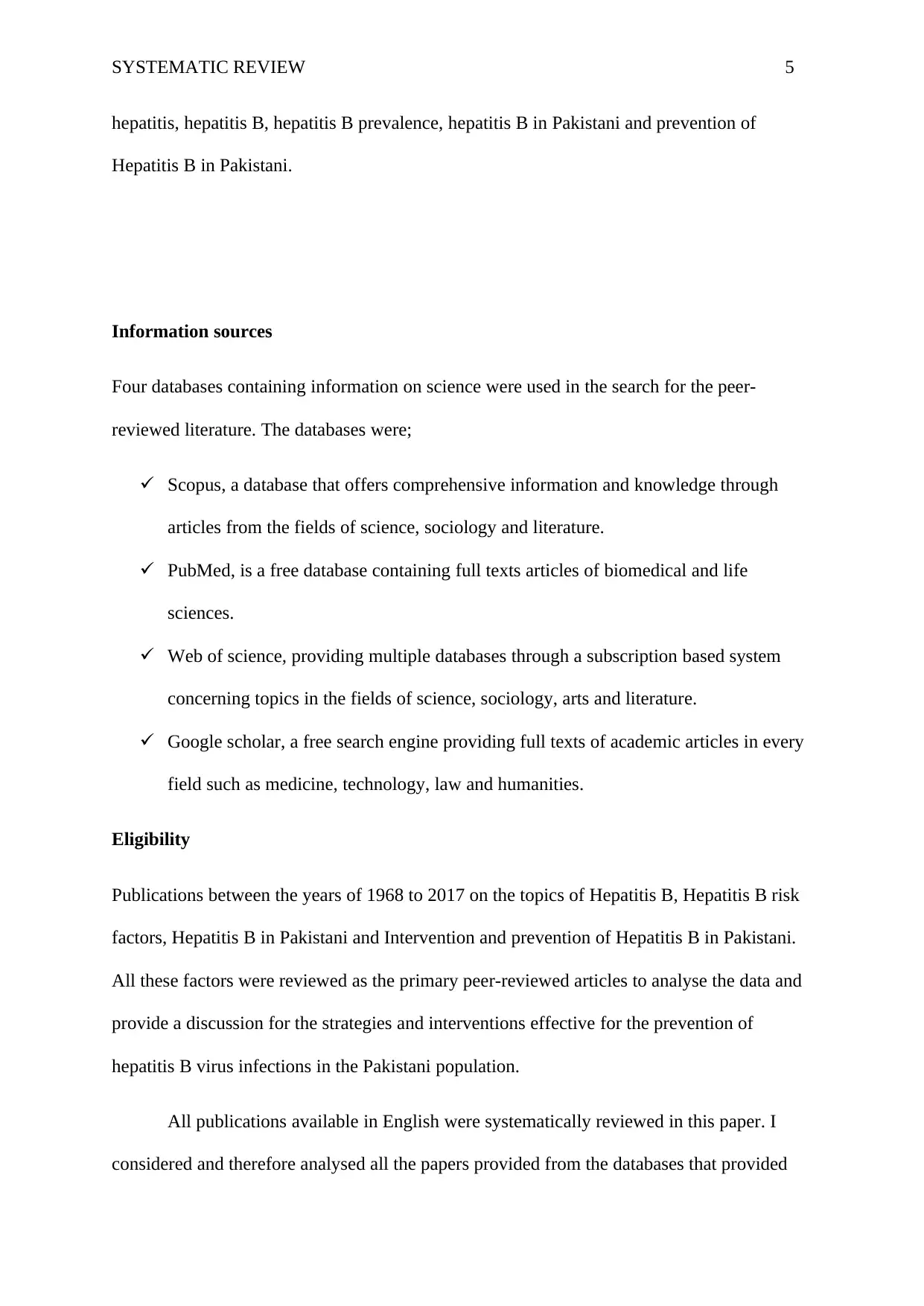
SYSTEMATIC REVIEW 5
hepatitis, hepatitis B, hepatitis B prevalence, hepatitis B in Pakistani and prevention of
Hepatitis B in Pakistani.
Information sources
Four databases containing information on science were used in the search for the peer-
reviewed literature. The databases were;
Scopus, a database that offers comprehensive information and knowledge through
articles from the fields of science, sociology and literature.
PubMed, is a free database containing full texts articles of biomedical and life
sciences.
Web of science, providing multiple databases through a subscription based system
concerning topics in the fields of science, sociology, arts and literature.
Google scholar, a free search engine providing full texts of academic articles in every
field such as medicine, technology, law and humanities.
Eligibility
Publications between the years of 1968 to 2017 on the topics of Hepatitis B, Hepatitis B risk
factors, Hepatitis B in Pakistani and Intervention and prevention of Hepatitis B in Pakistani.
All these factors were reviewed as the primary peer-reviewed articles to analyse the data and
provide a discussion for the strategies and interventions effective for the prevention of
hepatitis B virus infections in the Pakistani population.
All publications available in English were systematically reviewed in this paper. I
considered and therefore analysed all the papers provided from the databases that provided
hepatitis, hepatitis B, hepatitis B prevalence, hepatitis B in Pakistani and prevention of
Hepatitis B in Pakistani.
Information sources
Four databases containing information on science were used in the search for the peer-
reviewed literature. The databases were;
Scopus, a database that offers comprehensive information and knowledge through
articles from the fields of science, sociology and literature.
PubMed, is a free database containing full texts articles of biomedical and life
sciences.
Web of science, providing multiple databases through a subscription based system
concerning topics in the fields of science, sociology, arts and literature.
Google scholar, a free search engine providing full texts of academic articles in every
field such as medicine, technology, law and humanities.
Eligibility
Publications between the years of 1968 to 2017 on the topics of Hepatitis B, Hepatitis B risk
factors, Hepatitis B in Pakistani and Intervention and prevention of Hepatitis B in Pakistani.
All these factors were reviewed as the primary peer-reviewed articles to analyse the data and
provide a discussion for the strategies and interventions effective for the prevention of
hepatitis B virus infections in the Pakistani population.
All publications available in English were systematically reviewed in this paper. I
considered and therefore analysed all the papers provided from the databases that provided
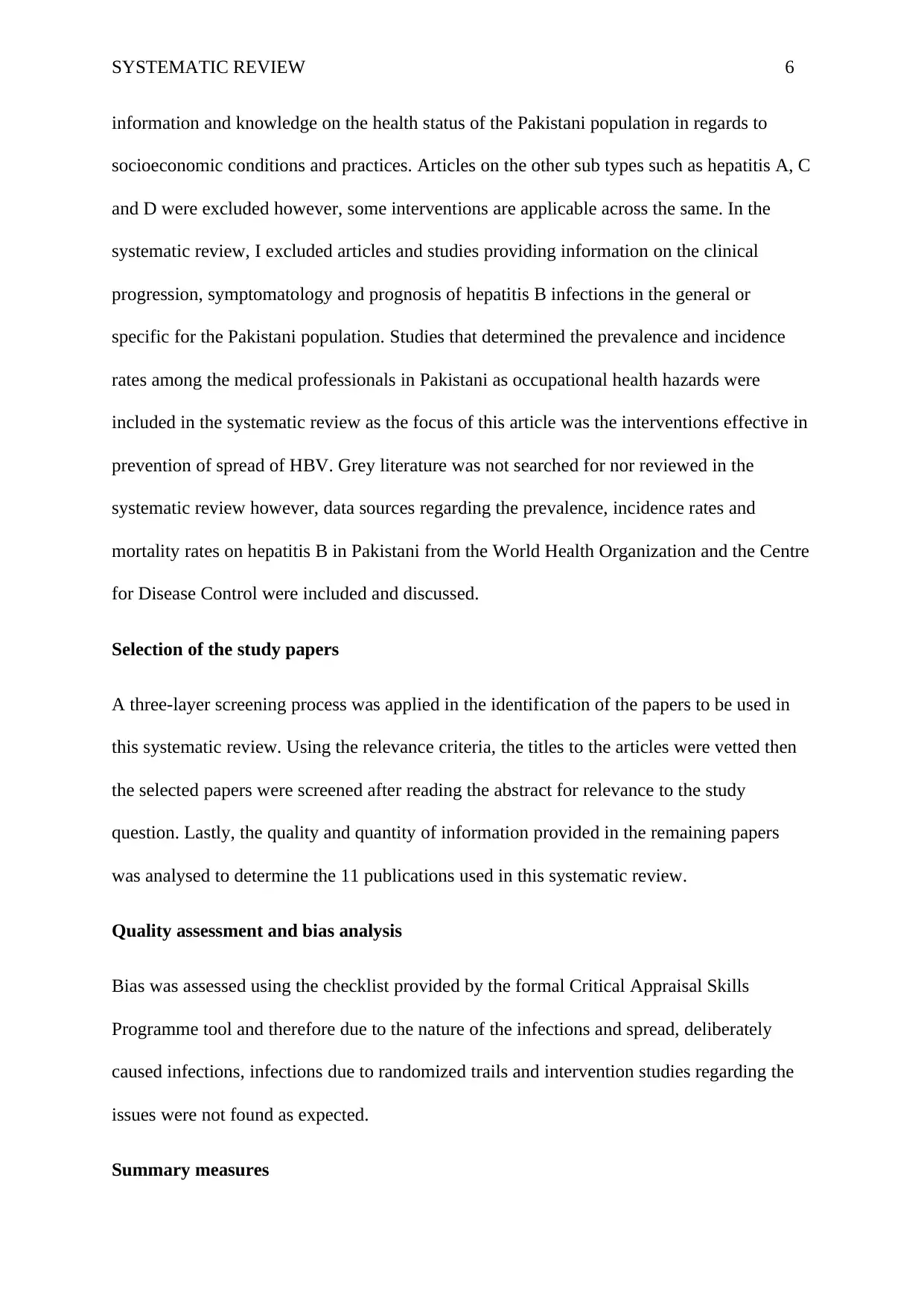
SYSTEMATIC REVIEW 6
information and knowledge on the health status of the Pakistani population in regards to
socioeconomic conditions and practices. Articles on the other sub types such as hepatitis A, C
and D were excluded however, some interventions are applicable across the same. In the
systematic review, I excluded articles and studies providing information on the clinical
progression, symptomatology and prognosis of hepatitis B infections in the general or
specific for the Pakistani population. Studies that determined the prevalence and incidence
rates among the medical professionals in Pakistani as occupational health hazards were
included in the systematic review as the focus of this article was the interventions effective in
prevention of spread of HBV. Grey literature was not searched for nor reviewed in the
systematic review however, data sources regarding the prevalence, incidence rates and
mortality rates on hepatitis B in Pakistani from the World Health Organization and the Centre
for Disease Control were included and discussed.
Selection of the study papers
A three-layer screening process was applied in the identification of the papers to be used in
this systematic review. Using the relevance criteria, the titles to the articles were vetted then
the selected papers were screened after reading the abstract for relevance to the study
question. Lastly, the quality and quantity of information provided in the remaining papers
was analysed to determine the 11 publications used in this systematic review.
Quality assessment and bias analysis
Bias was assessed using the checklist provided by the formal Critical Appraisal Skills
Programme tool and therefore due to the nature of the infections and spread, deliberately
caused infections, infections due to randomized trails and intervention studies regarding the
issues were not found as expected.
Summary measures
information and knowledge on the health status of the Pakistani population in regards to
socioeconomic conditions and practices. Articles on the other sub types such as hepatitis A, C
and D were excluded however, some interventions are applicable across the same. In the
systematic review, I excluded articles and studies providing information on the clinical
progression, symptomatology and prognosis of hepatitis B infections in the general or
specific for the Pakistani population. Studies that determined the prevalence and incidence
rates among the medical professionals in Pakistani as occupational health hazards were
included in the systematic review as the focus of this article was the interventions effective in
prevention of spread of HBV. Grey literature was not searched for nor reviewed in the
systematic review however, data sources regarding the prevalence, incidence rates and
mortality rates on hepatitis B in Pakistani from the World Health Organization and the Centre
for Disease Control were included and discussed.
Selection of the study papers
A three-layer screening process was applied in the identification of the papers to be used in
this systematic review. Using the relevance criteria, the titles to the articles were vetted then
the selected papers were screened after reading the abstract for relevance to the study
question. Lastly, the quality and quantity of information provided in the remaining papers
was analysed to determine the 11 publications used in this systematic review.
Quality assessment and bias analysis
Bias was assessed using the checklist provided by the formal Critical Appraisal Skills
Programme tool and therefore due to the nature of the infections and spread, deliberately
caused infections, infections due to randomized trails and intervention studies regarding the
issues were not found as expected.
Summary measures
⊘ This is a preview!⊘
Do you want full access?
Subscribe today to unlock all pages.

Trusted by 1+ million students worldwide
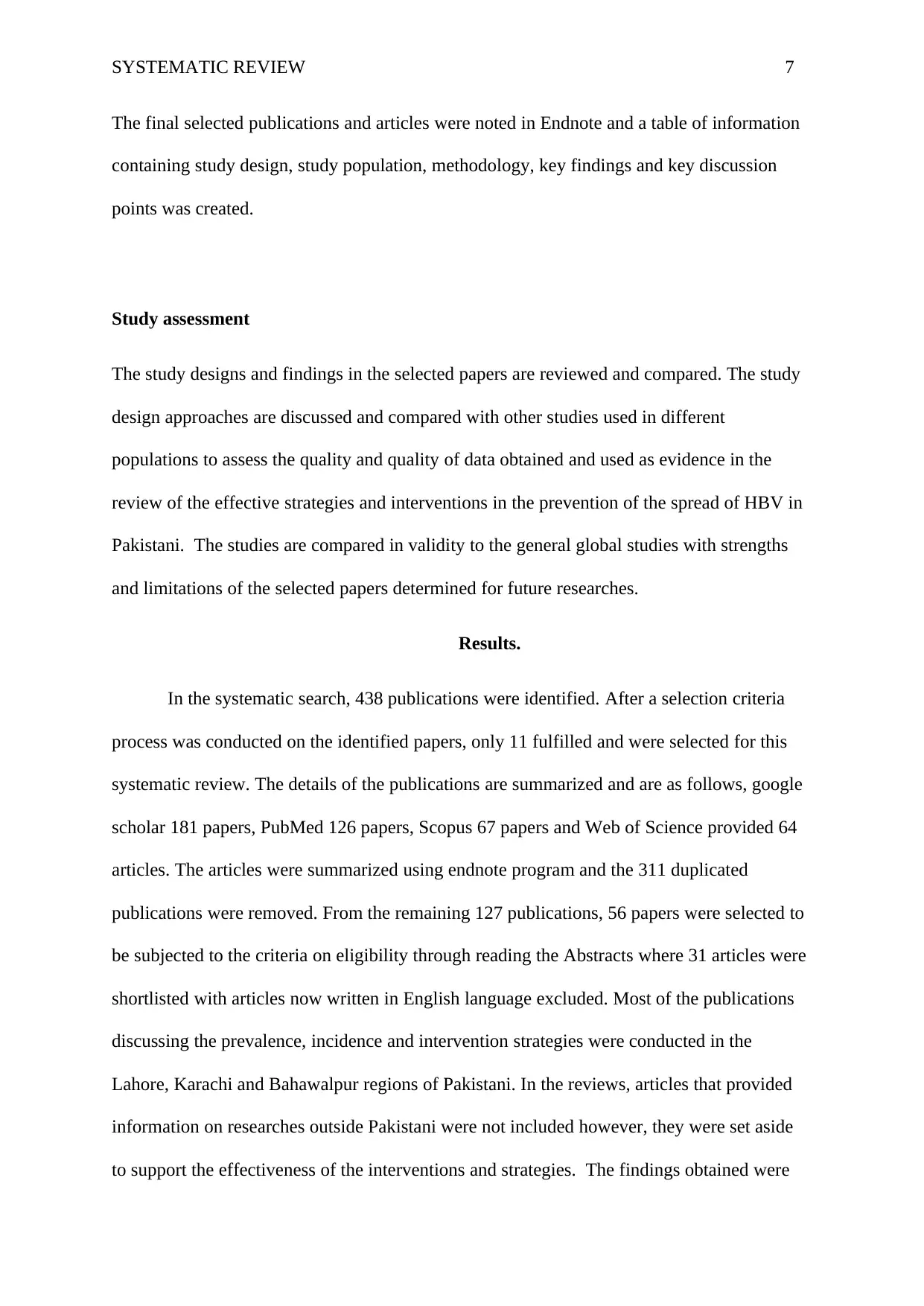
SYSTEMATIC REVIEW 7
The final selected publications and articles were noted in Endnote and a table of information
containing study design, study population, methodology, key findings and key discussion
points was created.
Study assessment
The study designs and findings in the selected papers are reviewed and compared. The study
design approaches are discussed and compared with other studies used in different
populations to assess the quality and quality of data obtained and used as evidence in the
review of the effective strategies and interventions in the prevention of the spread of HBV in
Pakistani. The studies are compared in validity to the general global studies with strengths
and limitations of the selected papers determined for future researches.
Results.
In the systematic search, 438 publications were identified. After a selection criteria
process was conducted on the identified papers, only 11 fulfilled and were selected for this
systematic review. The details of the publications are summarized and are as follows, google
scholar 181 papers, PubMed 126 papers, Scopus 67 papers and Web of Science provided 64
articles. The articles were summarized using endnote program and the 311 duplicated
publications were removed. From the remaining 127 publications, 56 papers were selected to
be subjected to the criteria on eligibility through reading the Abstracts where 31 articles were
shortlisted with articles now written in English language excluded. Most of the publications
discussing the prevalence, incidence and intervention strategies were conducted in the
Lahore, Karachi and Bahawalpur regions of Pakistani. In the reviews, articles that provided
information on researches outside Pakistani were not included however, they were set aside
to support the effectiveness of the interventions and strategies. The findings obtained were
The final selected publications and articles were noted in Endnote and a table of information
containing study design, study population, methodology, key findings and key discussion
points was created.
Study assessment
The study designs and findings in the selected papers are reviewed and compared. The study
design approaches are discussed and compared with other studies used in different
populations to assess the quality and quality of data obtained and used as evidence in the
review of the effective strategies and interventions in the prevention of the spread of HBV in
Pakistani. The studies are compared in validity to the general global studies with strengths
and limitations of the selected papers determined for future researches.
Results.
In the systematic search, 438 publications were identified. After a selection criteria
process was conducted on the identified papers, only 11 fulfilled and were selected for this
systematic review. The details of the publications are summarized and are as follows, google
scholar 181 papers, PubMed 126 papers, Scopus 67 papers and Web of Science provided 64
articles. The articles were summarized using endnote program and the 311 duplicated
publications were removed. From the remaining 127 publications, 56 papers were selected to
be subjected to the criteria on eligibility through reading the Abstracts where 31 articles were
shortlisted with articles now written in English language excluded. Most of the publications
discussing the prevalence, incidence and intervention strategies were conducted in the
Lahore, Karachi and Bahawalpur regions of Pakistani. In the reviews, articles that provided
information on researches outside Pakistani were not included however, they were set aside
to support the effectiveness of the interventions and strategies. The findings obtained were
Paraphrase This Document
Need a fresh take? Get an instant paraphrase of this document with our AI Paraphraser
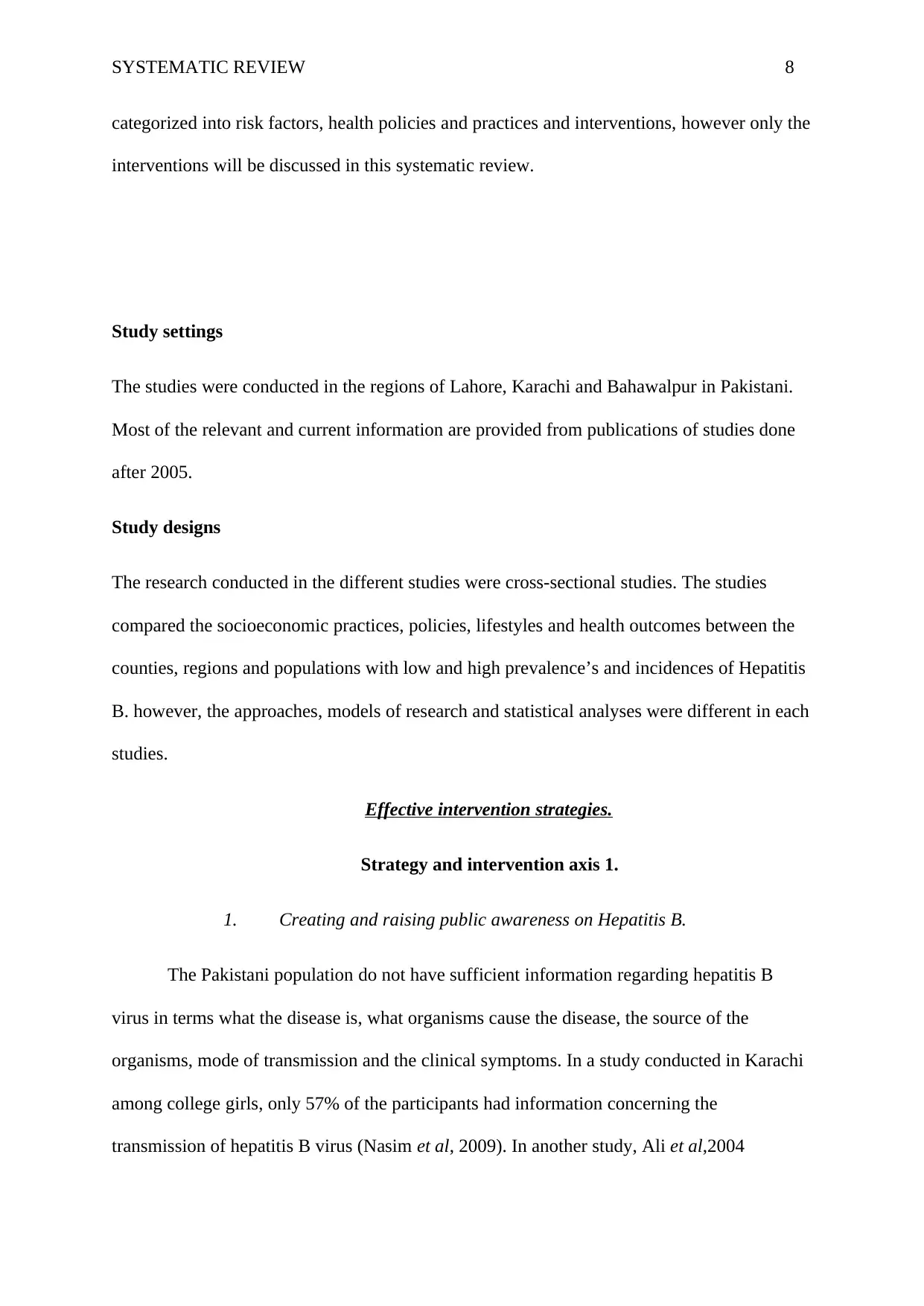
SYSTEMATIC REVIEW 8
categorized into risk factors, health policies and practices and interventions, however only the
interventions will be discussed in this systematic review.
Study settings
The studies were conducted in the regions of Lahore, Karachi and Bahawalpur in Pakistani.
Most of the relevant and current information are provided from publications of studies done
after 2005.
Study designs
The research conducted in the different studies were cross-sectional studies. The studies
compared the socioeconomic practices, policies, lifestyles and health outcomes between the
counties, regions and populations with low and high prevalence’s and incidences of Hepatitis
B. however, the approaches, models of research and statistical analyses were different in each
studies.
Effective intervention strategies.
Strategy and intervention axis 1.
1. Creating and raising public awareness on Hepatitis B.
The Pakistani population do not have sufficient information regarding hepatitis B
virus in terms what the disease is, what organisms cause the disease, the source of the
organisms, mode of transmission and the clinical symptoms. In a study conducted in Karachi
among college girls, only 57% of the participants had information concerning the
transmission of hepatitis B virus (Nasim et al, 2009). In another study, Ali et al,2004
categorized into risk factors, health policies and practices and interventions, however only the
interventions will be discussed in this systematic review.
Study settings
The studies were conducted in the regions of Lahore, Karachi and Bahawalpur in Pakistani.
Most of the relevant and current information are provided from publications of studies done
after 2005.
Study designs
The research conducted in the different studies were cross-sectional studies. The studies
compared the socioeconomic practices, policies, lifestyles and health outcomes between the
counties, regions and populations with low and high prevalence’s and incidences of Hepatitis
B. however, the approaches, models of research and statistical analyses were different in each
studies.
Effective intervention strategies.
Strategy and intervention axis 1.
1. Creating and raising public awareness on Hepatitis B.
The Pakistani population do not have sufficient information regarding hepatitis B
virus in terms what the disease is, what organisms cause the disease, the source of the
organisms, mode of transmission and the clinical symptoms. In a study conducted in Karachi
among college girls, only 57% of the participants had information concerning the
transmission of hepatitis B virus (Nasim et al, 2009). In another study, Ali et al,2004
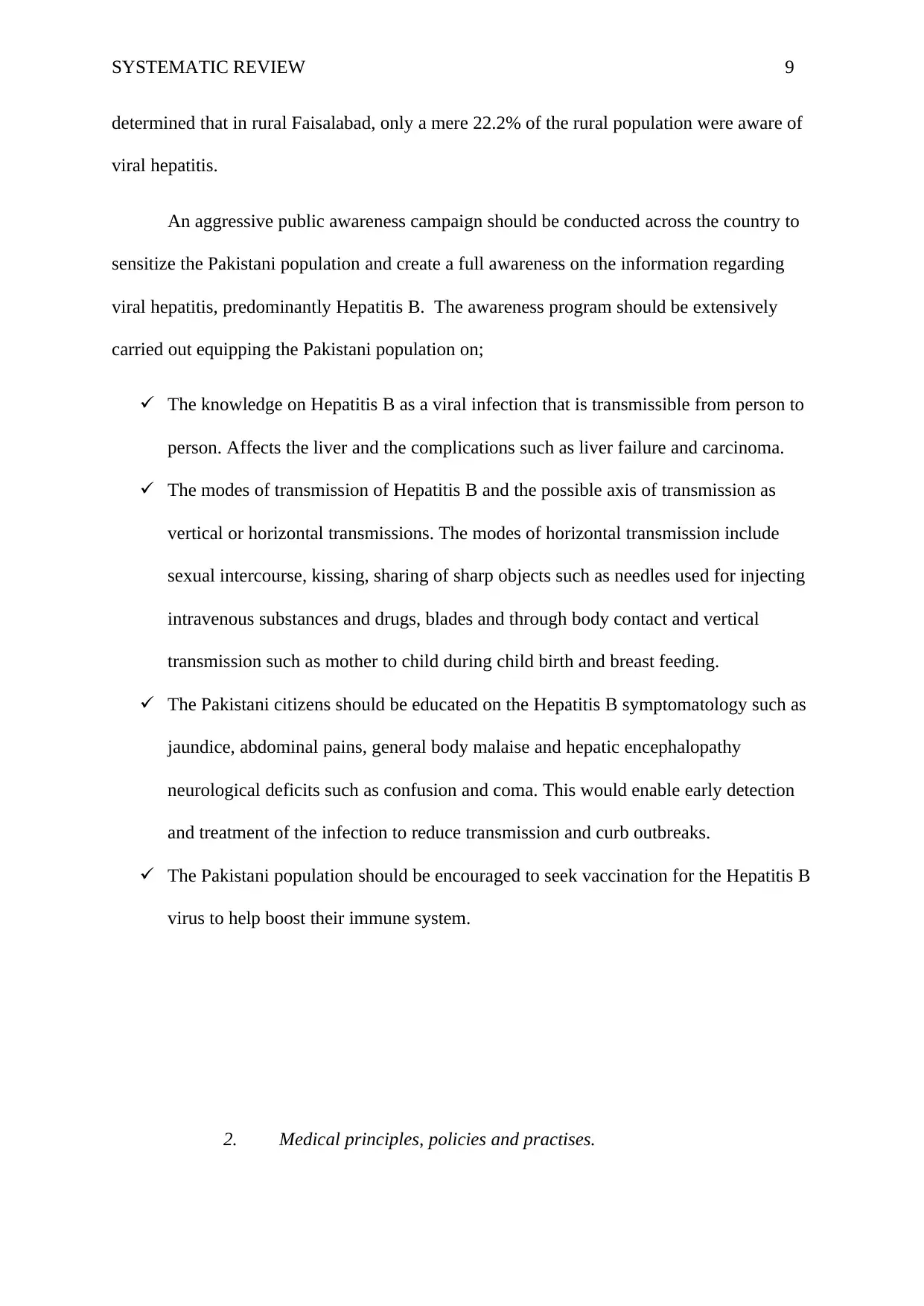
SYSTEMATIC REVIEW 9
determined that in rural Faisalabad, only a mere 22.2% of the rural population were aware of
viral hepatitis.
An aggressive public awareness campaign should be conducted across the country to
sensitize the Pakistani population and create a full awareness on the information regarding
viral hepatitis, predominantly Hepatitis B. The awareness program should be extensively
carried out equipping the Pakistani population on;
The knowledge on Hepatitis B as a viral infection that is transmissible from person to
person. Affects the liver and the complications such as liver failure and carcinoma.
The modes of transmission of Hepatitis B and the possible axis of transmission as
vertical or horizontal transmissions. The modes of horizontal transmission include
sexual intercourse, kissing, sharing of sharp objects such as needles used for injecting
intravenous substances and drugs, blades and through body contact and vertical
transmission such as mother to child during child birth and breast feeding.
The Pakistani citizens should be educated on the Hepatitis B symptomatology such as
jaundice, abdominal pains, general body malaise and hepatic encephalopathy
neurological deficits such as confusion and coma. This would enable early detection
and treatment of the infection to reduce transmission and curb outbreaks.
The Pakistani population should be encouraged to seek vaccination for the Hepatitis B
virus to help boost their immune system.
2. Medical principles, policies and practises.
determined that in rural Faisalabad, only a mere 22.2% of the rural population were aware of
viral hepatitis.
An aggressive public awareness campaign should be conducted across the country to
sensitize the Pakistani population and create a full awareness on the information regarding
viral hepatitis, predominantly Hepatitis B. The awareness program should be extensively
carried out equipping the Pakistani population on;
The knowledge on Hepatitis B as a viral infection that is transmissible from person to
person. Affects the liver and the complications such as liver failure and carcinoma.
The modes of transmission of Hepatitis B and the possible axis of transmission as
vertical or horizontal transmissions. The modes of horizontal transmission include
sexual intercourse, kissing, sharing of sharp objects such as needles used for injecting
intravenous substances and drugs, blades and through body contact and vertical
transmission such as mother to child during child birth and breast feeding.
The Pakistani citizens should be educated on the Hepatitis B symptomatology such as
jaundice, abdominal pains, general body malaise and hepatic encephalopathy
neurological deficits such as confusion and coma. This would enable early detection
and treatment of the infection to reduce transmission and curb outbreaks.
The Pakistani population should be encouraged to seek vaccination for the Hepatitis B
virus to help boost their immune system.
2. Medical principles, policies and practises.
⊘ This is a preview!⊘
Do you want full access?
Subscribe today to unlock all pages.

Trusted by 1+ million students worldwide
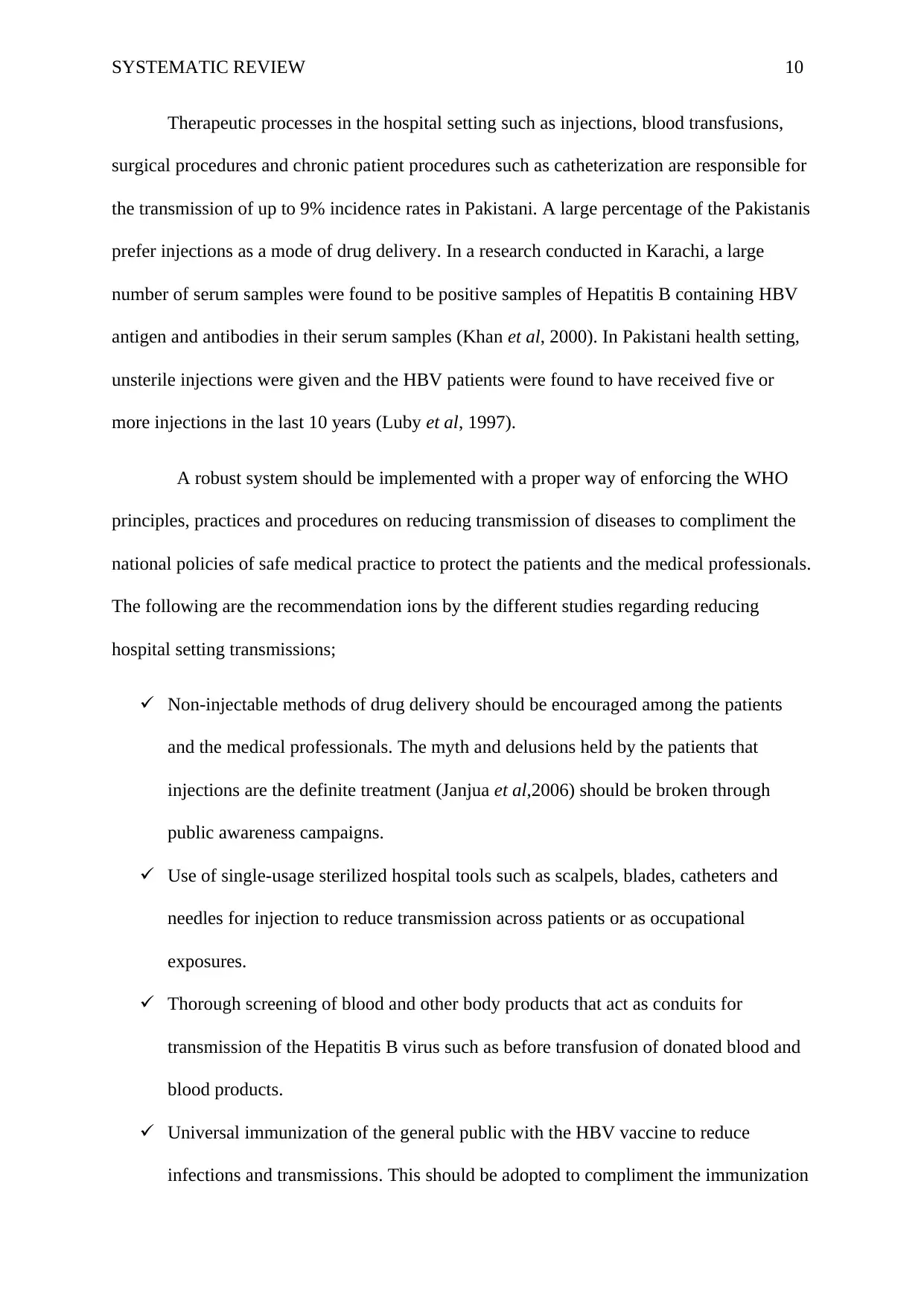
SYSTEMATIC REVIEW 10
Therapeutic processes in the hospital setting such as injections, blood transfusions,
surgical procedures and chronic patient procedures such as catheterization are responsible for
the transmission of up to 9% incidence rates in Pakistani. A large percentage of the Pakistanis
prefer injections as a mode of drug delivery. In a research conducted in Karachi, a large
number of serum samples were found to be positive samples of Hepatitis B containing HBV
antigen and antibodies in their serum samples (Khan et al, 2000). In Pakistani health setting,
unsterile injections were given and the HBV patients were found to have received five or
more injections in the last 10 years (Luby et al, 1997).
A robust system should be implemented with a proper way of enforcing the WHO
principles, practices and procedures on reducing transmission of diseases to compliment the
national policies of safe medical practice to protect the patients and the medical professionals.
The following are the recommendation ions by the different studies regarding reducing
hospital setting transmissions;
Non-injectable methods of drug delivery should be encouraged among the patients
and the medical professionals. The myth and delusions held by the patients that
injections are the definite treatment (Janjua et al,2006) should be broken through
public awareness campaigns.
Use of single-usage sterilized hospital tools such as scalpels, blades, catheters and
needles for injection to reduce transmission across patients or as occupational
exposures.
Thorough screening of blood and other body products that act as conduits for
transmission of the Hepatitis B virus such as before transfusion of donated blood and
blood products.
Universal immunization of the general public with the HBV vaccine to reduce
infections and transmissions. This should be adopted to compliment the immunization
Therapeutic processes in the hospital setting such as injections, blood transfusions,
surgical procedures and chronic patient procedures such as catheterization are responsible for
the transmission of up to 9% incidence rates in Pakistani. A large percentage of the Pakistanis
prefer injections as a mode of drug delivery. In a research conducted in Karachi, a large
number of serum samples were found to be positive samples of Hepatitis B containing HBV
antigen and antibodies in their serum samples (Khan et al, 2000). In Pakistani health setting,
unsterile injections were given and the HBV patients were found to have received five or
more injections in the last 10 years (Luby et al, 1997).
A robust system should be implemented with a proper way of enforcing the WHO
principles, practices and procedures on reducing transmission of diseases to compliment the
national policies of safe medical practice to protect the patients and the medical professionals.
The following are the recommendation ions by the different studies regarding reducing
hospital setting transmissions;
Non-injectable methods of drug delivery should be encouraged among the patients
and the medical professionals. The myth and delusions held by the patients that
injections are the definite treatment (Janjua et al,2006) should be broken through
public awareness campaigns.
Use of single-usage sterilized hospital tools such as scalpels, blades, catheters and
needles for injection to reduce transmission across patients or as occupational
exposures.
Thorough screening of blood and other body products that act as conduits for
transmission of the Hepatitis B virus such as before transfusion of donated blood and
blood products.
Universal immunization of the general public with the HBV vaccine to reduce
infections and transmissions. This should be adopted to compliment the immunization
Paraphrase This Document
Need a fresh take? Get an instant paraphrase of this document with our AI Paraphraser
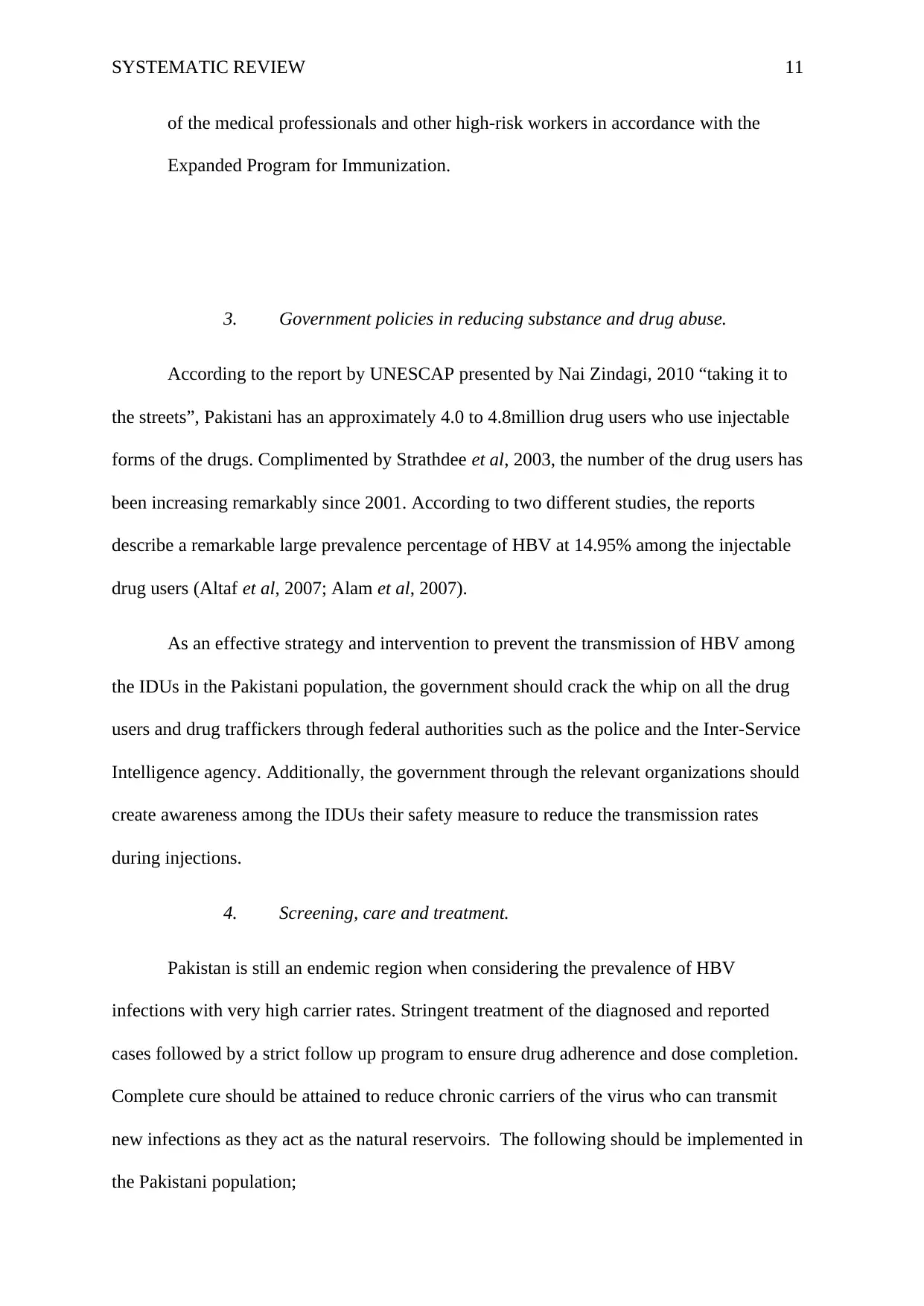
SYSTEMATIC REVIEW 11
of the medical professionals and other high-risk workers in accordance with the
Expanded Program for Immunization.
3. Government policies in reducing substance and drug abuse.
According to the report by UNESCAP presented by Nai Zindagi, 2010 “taking it to
the streets”, Pakistani has an approximately 4.0 to 4.8million drug users who use injectable
forms of the drugs. Complimented by Strathdee et al, 2003, the number of the drug users has
been increasing remarkably since 2001. According to two different studies, the reports
describe a remarkable large prevalence percentage of HBV at 14.95% among the injectable
drug users (Altaf et al, 2007; Alam et al, 2007).
As an effective strategy and intervention to prevent the transmission of HBV among
the IDUs in the Pakistani population, the government should crack the whip on all the drug
users and drug traffickers through federal authorities such as the police and the Inter-Service
Intelligence agency. Additionally, the government through the relevant organizations should
create awareness among the IDUs their safety measure to reduce the transmission rates
during injections.
4. Screening, care and treatment.
Pakistan is still an endemic region when considering the prevalence of HBV
infections with very high carrier rates. Stringent treatment of the diagnosed and reported
cases followed by a strict follow up program to ensure drug adherence and dose completion.
Complete cure should be attained to reduce chronic carriers of the virus who can transmit
new infections as they act as the natural reservoirs. The following should be implemented in
the Pakistani population;
of the medical professionals and other high-risk workers in accordance with the
Expanded Program for Immunization.
3. Government policies in reducing substance and drug abuse.
According to the report by UNESCAP presented by Nai Zindagi, 2010 “taking it to
the streets”, Pakistani has an approximately 4.0 to 4.8million drug users who use injectable
forms of the drugs. Complimented by Strathdee et al, 2003, the number of the drug users has
been increasing remarkably since 2001. According to two different studies, the reports
describe a remarkable large prevalence percentage of HBV at 14.95% among the injectable
drug users (Altaf et al, 2007; Alam et al, 2007).
As an effective strategy and intervention to prevent the transmission of HBV among
the IDUs in the Pakistani population, the government should crack the whip on all the drug
users and drug traffickers through federal authorities such as the police and the Inter-Service
Intelligence agency. Additionally, the government through the relevant organizations should
create awareness among the IDUs their safety measure to reduce the transmission rates
during injections.
4. Screening, care and treatment.
Pakistan is still an endemic region when considering the prevalence of HBV
infections with very high carrier rates. Stringent treatment of the diagnosed and reported
cases followed by a strict follow up program to ensure drug adherence and dose completion.
Complete cure should be attained to reduce chronic carriers of the virus who can transmit
new infections as they act as the natural reservoirs. The following should be implemented in
the Pakistani population;
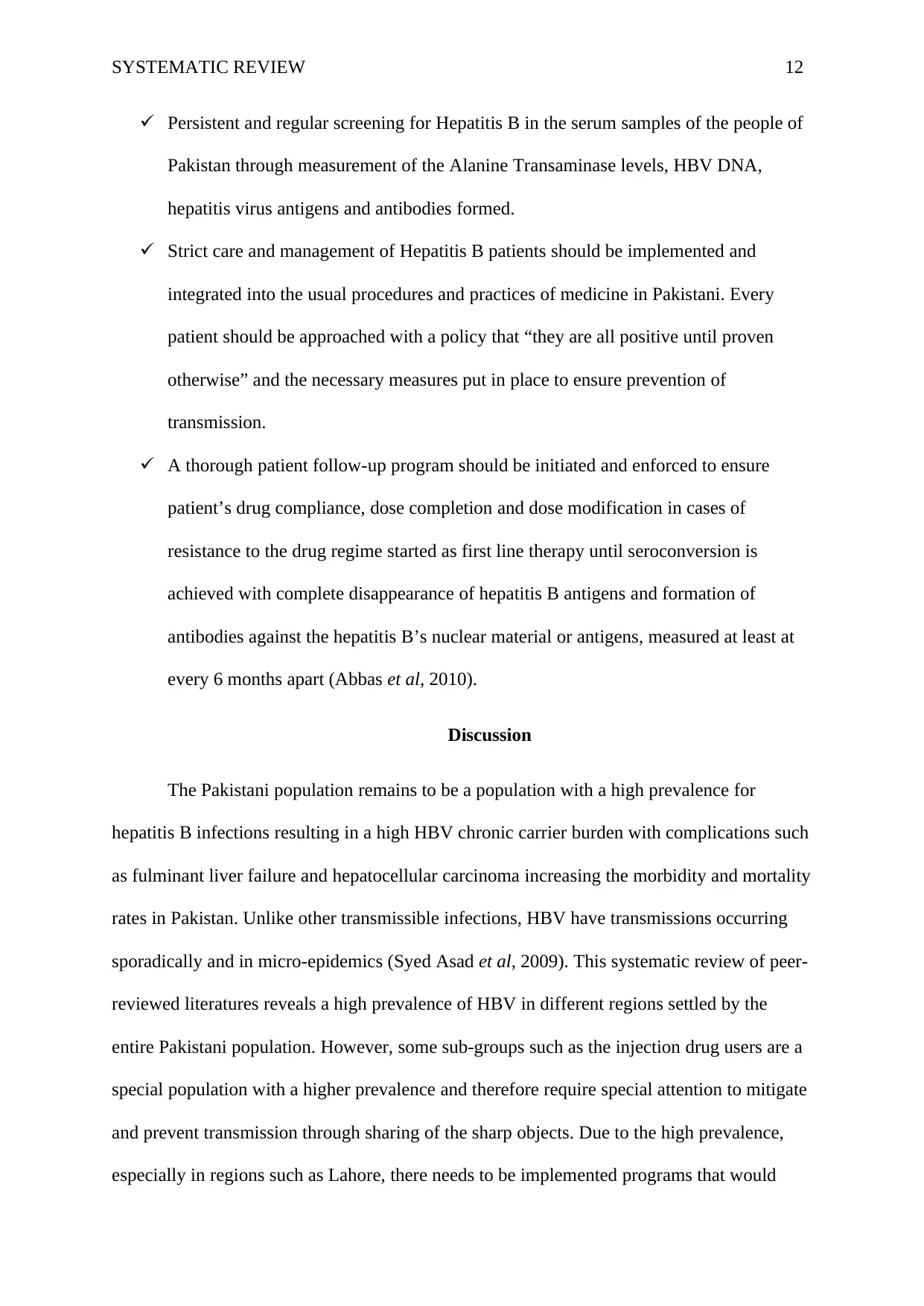
SYSTEMATIC REVIEW 12
Persistent and regular screening for Hepatitis B in the serum samples of the people of
Pakistan through measurement of the Alanine Transaminase levels, HBV DNA,
hepatitis virus antigens and antibodies formed.
Strict care and management of Hepatitis B patients should be implemented and
integrated into the usual procedures and practices of medicine in Pakistani. Every
patient should be approached with a policy that “they are all positive until proven
otherwise” and the necessary measures put in place to ensure prevention of
transmission.
A thorough patient follow-up program should be initiated and enforced to ensure
patient’s drug compliance, dose completion and dose modification in cases of
resistance to the drug regime started as first line therapy until seroconversion is
achieved with complete disappearance of hepatitis B antigens and formation of
antibodies against the hepatitis B’s nuclear material or antigens, measured at least at
every 6 months apart (Abbas et al, 2010).
Discussion
The Pakistani population remains to be a population with a high prevalence for
hepatitis B infections resulting in a high HBV chronic carrier burden with complications such
as fulminant liver failure and hepatocellular carcinoma increasing the morbidity and mortality
rates in Pakistan. Unlike other transmissible infections, HBV have transmissions occurring
sporadically and in micro-epidemics (Syed Asad et al, 2009). This systematic review of peer-
reviewed literatures reveals a high prevalence of HBV in different regions settled by the
entire Pakistani population. However, some sub-groups such as the injection drug users are a
special population with a higher prevalence and therefore require special attention to mitigate
and prevent transmission through sharing of the sharp objects. Due to the high prevalence,
especially in regions such as Lahore, there needs to be implemented programs that would
Persistent and regular screening for Hepatitis B in the serum samples of the people of
Pakistan through measurement of the Alanine Transaminase levels, HBV DNA,
hepatitis virus antigens and antibodies formed.
Strict care and management of Hepatitis B patients should be implemented and
integrated into the usual procedures and practices of medicine in Pakistani. Every
patient should be approached with a policy that “they are all positive until proven
otherwise” and the necessary measures put in place to ensure prevention of
transmission.
A thorough patient follow-up program should be initiated and enforced to ensure
patient’s drug compliance, dose completion and dose modification in cases of
resistance to the drug regime started as first line therapy until seroconversion is
achieved with complete disappearance of hepatitis B antigens and formation of
antibodies against the hepatitis B’s nuclear material or antigens, measured at least at
every 6 months apart (Abbas et al, 2010).
Discussion
The Pakistani population remains to be a population with a high prevalence for
hepatitis B infections resulting in a high HBV chronic carrier burden with complications such
as fulminant liver failure and hepatocellular carcinoma increasing the morbidity and mortality
rates in Pakistan. Unlike other transmissible infections, HBV have transmissions occurring
sporadically and in micro-epidemics (Syed Asad et al, 2009). This systematic review of peer-
reviewed literatures reveals a high prevalence of HBV in different regions settled by the
entire Pakistani population. However, some sub-groups such as the injection drug users are a
special population with a higher prevalence and therefore require special attention to mitigate
and prevent transmission through sharing of the sharp objects. Due to the high prevalence,
especially in regions such as Lahore, there needs to be implemented programs that would
⊘ This is a preview!⊘
Do you want full access?
Subscribe today to unlock all pages.

Trusted by 1+ million students worldwide
1 out of 22
Related Documents
Your All-in-One AI-Powered Toolkit for Academic Success.
+13062052269
info@desklib.com
Available 24*7 on WhatsApp / Email
![[object Object]](/_next/static/media/star-bottom.7253800d.svg)
Unlock your academic potential
Copyright © 2020–2025 A2Z Services. All Rights Reserved. Developed and managed by ZUCOL.





